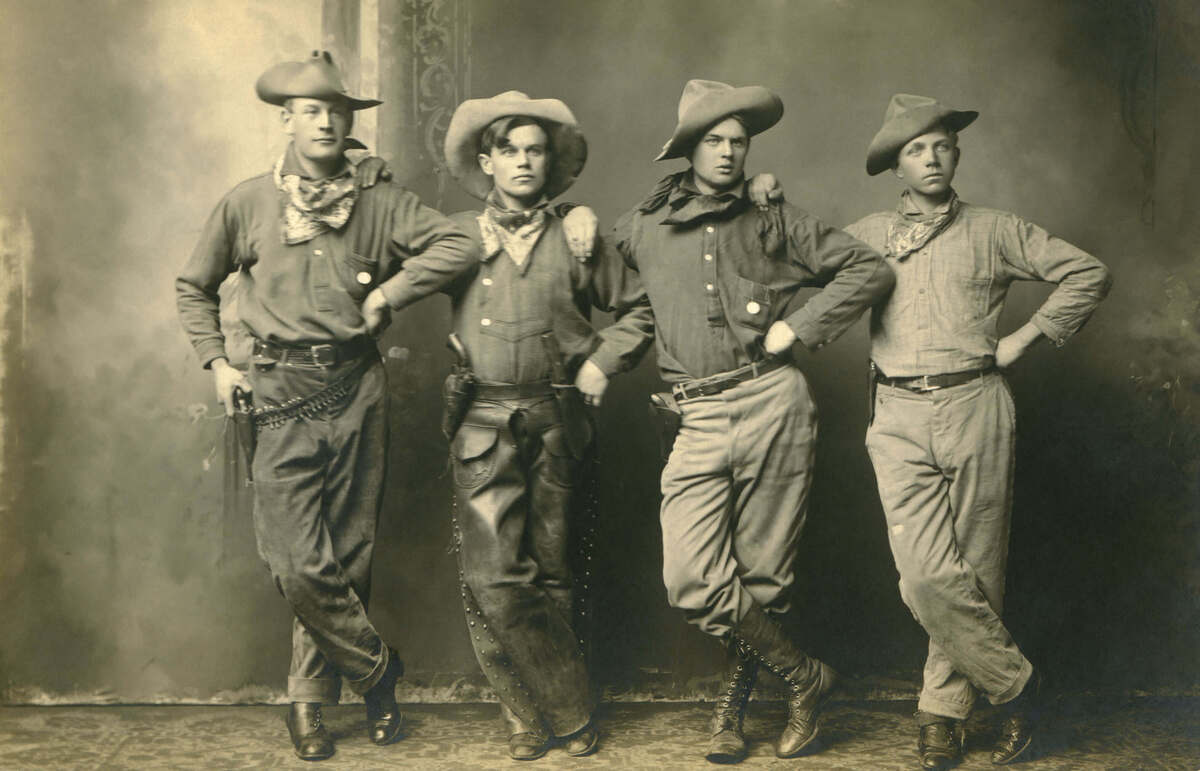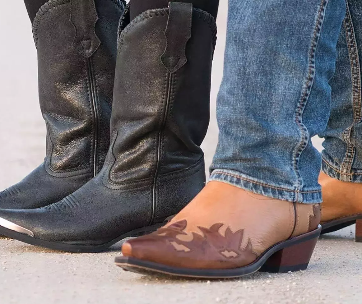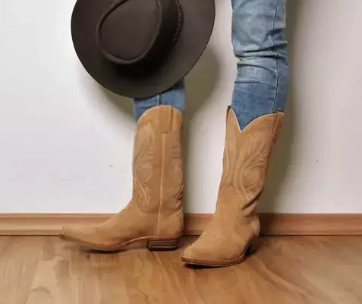Cowboy boots refer to a special riding boot made of stacked leather and characterized by a high heel, high shaft, no lacing and a rounded or pointed toe.
They were traditionally worn by cowboys at a time when horses were the primary means of transportation but over the years these shoes evolved to become a legendary fashion footwear serving both function and fashion.
Being the longest serving men’s footwear, there is no doubt that this boot will forever be the most popular type of shoe to have ever been designed.
But how exactly did they come about and what made them gain the popularity that they have till date?
Let’s go back to the very beginning, shall we?
Earliest record of the cowboy boot
First things first, there has always been a special type of shoe specific to the equestrian life. And contrary to what a lot of people may think, the cowboy boot doesn’t have its origins in the west.
Chronology dates the first sighting of a boot similar to the cowboy boot back to the 12th century. However, it wasn’t until the 1800s that the cowboy boot that we know now first made an appearance.
The cowboy boot is an assortment of different styles that influenced the Western culture between the 12th century and the 19th century that thereby influenced the design of the cowboy boot.
The Mongolian leather boot
12th Century - It can be said that the Mongolians were the first to be spotted with leather boots with wooden heels.
Historical records show that the cowboy boot can be traced back to Genghis Khan’s invasion of Europe with his Mongol hordes. He was spotted wearing characteristic red leather boots that featured wooden heels.
As you know, in the simplest of terms, the cowboy boot can be described as a leather boot with a raised heel. This then makes the leather boot the first predecessor of the cowboy boot.
The Vaquero style boot
Another heavy influence of the early cowboy boot designs was the vaquero tradition that was imported from Spain to America as early as the 16th century.
The next few centuries entailed a similar style of footwear all across Europe but it wasn’t until the 17th and 18th century that English riding boots brought this shoes back with overwhelming popularity.
The Hessian boot
If you follow closely, you will notice that the shoe always moved with the people and thus made its way into America.
The modern cowboy boot is a heavily influenced by two style of boots that were prominent at the time, and made their way to the west.
The first is an Anglo-German boot known as the Hessian boot and the second is the Wellington boot.
Initially, the Hessian boot was used as standard footwear for military officers. The boots feel below the knee and had a distinctive v-cut in the front.
The Wellington boot
In 1815, Arthur Wesley (then Duke of Wellington) defeated Napoleon at Waterloo and brought attention to the type of footwear he adorned while in combat.
Public attention was brought to the Wellington boot after the battle as these boots weren’t the popularized Hessian boots. They were a more custom version.
The boot fit closely to the leg and stopped mid-calf. That way, the boot would be comfortable outside the battle grounds yet still tough enough for battle.
The boots were named ‘Wellington boots’ in his honor; and that is what they go by to date.
We can say what was really distinct about this boot was its simplicity. Being made solely for utilitarian purposes, it was rather plain with black or brown leather, side seams and a one-inch heel.
The Duke of Wellington loved the footwear for its comfort and style and thereafter the boot became a symbol of aristocracy.
When the Europeans later colonized North America in the 19th century, they came with their culture. Thus, the heavy influx of Europeans into America made the Wellington boot a popular riding boot.
The Surge of American Cowboy Boots
The story of the origin of the American cowboy boots has been debated over the years and has been narrowed down to Kansas or Texas origins.
It isn’t even clear who initially made the first cowboy boot but the story dates back to the late 1800s as the American civil war came to an end.
During the civil war, cavalry boots (a sturdier version of the Wellington boot) were worn by the men who served in the military but soon after it proved that they were not suitable for the long hours of riding on horses and enduring tough trails.
As the war ended in 1865, many former soldiers moved to the west where the land was cheap for farming and they adopted a farming and herding lifestyle. It was then that it became apparent that a different kind of footwear was needed to withstand the harsh conditions of the trail.
The riders would travel cross-country while herding through brush, brambles and creek and sometimes heavily rugged terrain.
The golden cowboy era and the first cowboy boot
1870 - Around this time, one ingenious cowboy got fed up with the harsh conditions and stopped by a local shoemaker to inquire about more suitable changes.
It is said that a customized boot with the distinctive features of the infamous cowboy boot was made by one Charles Hyer.
The changes entailed a taller shaft to keep the cowboy’s lower legs protected from thorns, snakes and other perils as well as to keep water and mud from running into the boot. In the absence of lacing, the taller shaft also served to hold the boot in place.
It also entailed a high underslung heel which kept the rider’s foot securely locked in the stirrup for those long and rough cattle drives.
A pointy toe and slick tread-less sole would ease the mounting of his foot into the stirrup of the horse’s saddle.
At the top, the boots were loose enough so that if need be, he would easily wiggle out of the boots and be able to make a hasty exit off the horse without endangering himself.
Not only that, but the boots were made from tough and thick leather which served to protect the rider’s ankle from being bruised by the stirrup.
Even the outside stitching was intentional. It was made like so in order to prevent the boot from folding towards the inside as well as to hinder the leather from rubbing against the cowboy’s leg inwardly.
Ultimately, every part of the boot was made for protection and to enhance comfort.
1866-1886
The golden cowboy era saw the popularization of the cowboy boots.
The cowboy who initiated the invention of the first American cowboy boot became a walking advertisement of the Charles Hyers’ little shop.
The farm workers who wore the boots for their functionality and affordability would later be called cowboys; which is where the term ‘Cowboy boots’ originated from.
So functional were the boots that more and more cowboys developed an interest in them. Soon after, the shoes become part of a cowboy’s distinctive daily attire.
They were minimal on style and maximized on function and as far as color goes, they were either distinctively black or brown.
The cowboy boot continued rising in prominence that once it became a status symbol to buy a new pair after weeks or months on the trail.
Thereafter, boot makers began to automate the process of boot making by using patterns to speed up the production. In a matter of minutes, several boots would be made and subsequently, boot companies began to surface.
In 1883, San Antonio based Shoe Company known as Lucchese was founded. Alongside the Hyer Boot Company, these were the earliest brands by local boot makers.
The Industrial revolution and mass production
The industrial revolution came with mass production of boots due to an advancement in machines which would make the boots at an even more accelerated speeds than those of local boot makers.
It was also marked with new trends in the boot industry such as advertising. Boot manufacturers would feature their products in fashion magazines.
Around this time, a later addition to the design of riding boots known as spurs (which are rounded wheels that have jagged edges) was added. Although their function is inhumane to say the least, it served its purpose which was to cue the horse and make it run faster when the rider kicked the spur into the side of the horse.
By the end of the 19th century, the boots worn by ranch workers were still characterized by simple, plain and functional designs but more decorative version ‘dress boots’ emerged.
Beyond the Scope of Horse Riding
Wearing the cowboy boot became a trend with many cowboys owning a work pair as well as a dress boot that was worn outside the ranch.
In the early 1900s, another change occurred to the design of the boot. This time, the extremely pointed toe as opposed to the known squared or rounded toe of the boot emerged. Some argue that this change was purely for stylization and had no practical function as it can be uncomfortable. Still, others argued that it was for easily slipping into the stirrup.
That aside, the more elaborate version of the boot spread beyond the ranchers and rich gamblers, gunslingers, bounty hunters and basically anyone who could afford the boot.
This stylized boot was more expensive as it was not purely targeted at ranch workers.
Switch from function to fashion
The 1920s and 1930s saw the turn of cowboy boots into a fashion item due to the movies and radio shows about the Wild West.
1940 - Hollywood played a massive role in the rise in popularity and transformation of cowboy boot design from function to fashion. This is because the cowboy lifestyle was romanticized in Western films with particular attention given to the western boot.
During this craze of western movies, actors adorned intricate designs of the cowboy boots and locals would demand similar boots.
Function no longer being at the forefront of the make of the boot led to the boots being designed with varied patterns, bright and colorful designs, decorative stitching, metal decorations and even incorporated images from the west such as horses and cacti.
In addition to the classic cowhide leather, cowboy boots were made of more exotic skins such as snakeskin, ostrich skin, lizard skin, alligator, elephant, bison, stringay and buffalo skina among others.
This was the biggest turning point of cowboy boots from work wear to fashion wear such that the fancier the boot looked, the more appealing it was to the wearer.
Rise in popularity
1950s - The entertainment industry continued influencing the rise in popularity of cowboy boots as rodeos and country music became extremely popularized in the West.
Various styles, shapes and colors were used to make the infamous cowboy boot in a bid to meet the demands of millions of wearers.
It was then that a new form of the western boot known as the roper boot emerged to satisfy the needs of the riders. The roper boot was characterized by a much lower heel (less than one inch in height) that was squared off in shape and a shorter shaft (going above the ankle but below mid-calf) to enable easy dismounting of the rider in the case of calf roping as well as other rodeo activities.
1960s saw the basic riding boot come back in style. The demand of sturdy basic riding boots for the ranch-working Americans enabled some sort of equilibrium to be met between the function and fashion aspect of the cowboy boot.
The following years were met with even more flair and trends to keep up with as the boots became a staple fashion footwear.
Today
Since the early 1990s till date, boot manufacturers have been very adventurous in their boot making process.
Today, cowboy boots can be spotted with all manner of styles and materials to suit market changes. The styles include incorporating studs, rhinestones and other precious stones.
The features of the traditional riding boot are however still prevalent today so you can still find a plain-looking or handmade leather cowboy boot.
Now used famously for line dancing, the cowboy boot is still predominant as it were.
The Labor Aspect
Of course, part of the history of cowboy boots lies not only with the cowboys but also with the actual boot makers.
Traditionally, cowboys would personally go to the cobbler and have their feet measured for a custom fit. The boots were made by hand for the ranchers, cowboys, and any other person with an interest in this style of boots.
Tradition has it that the simplicity in the design of the cowboy boot made the shoes very affordable which was a plus for ranch workers; majority of whom wore them.
With time, due to the high demand that followed, shoemakers would streamline their process in order to make production more efficient and result in more output.
Boot makers developed machinery that built boots swiftly. Inevitably, the first mail-ordered boot companies surfaced to create standard boots that went by size.
Cowboy boots changed from being custom made to being mass produced but custom fit boots were still preferred and were worn by those who could afford it.
The industrial era made manufacturing of cowboy boots more efficient and less time consuming due to more advanced sewing machines. The boots were thus manufactured in large quantities and the business of boot making became even more lucrative.
Change in Design
The traditional cowboy boot had a signature look with the slanted Cuban heel, high shaft, and rounded or pointed toe region.
As you are aware, the West’s favorite footwear became a fashion statement and so did the design of the original cowboy boot.
These are the changes that have occurred in the design of the cowboy boot over the years;
Stitching
Traditionally, the cowboy boot featured stitching on the outside to keep the leather firm and therefore prevent it from folding within.
The outside stitching shifted from being plain black or brown to being more colorful and decorative.
Not only did the color of the thread change but also the design with some even having pictures sewn onto the boot.
The style began being influenced by people’s personal styles and boot makers would experiment with inlays, cutouts and overlays to add to the toe wrinkle (the straight line of stitches that ran across the boot).
Boot makers would challenge themselves to satisfy each individual’s desire as the more extraordinary the boot was, the better it was regarded.
Till date, this is the personalized signature of custom-made boots.
Material
The classic cowhide leather used to make cowboy boots has evolved such that exotic skins from just about any animal can be used to make cowboy boots.
Others are even made of faux leather so that animals are not endangered during the shoemaking process.
Lacing
While the traditional cowboy boots didn’t feature lacing because it posed a risk for the rider in case it got tangled up into the stirrup, today’s boots feature a lacing system for a more snug fit as you can expect more boots to be used for walking than working on a horse.
Sole
Lastly, the sole has changed from slick and tread-less to having traction in order to prevent the wearer from slipping while walking.
Even with all these changes, what is really interesting is that the raised heel and tall shaft which characterized the first cowboy boots still stand today. Otherwise, the cowboy boot just wouldn’t be the cowboy boot anymore, now would it?
Bottom Line
Ever since the cowboy boot touched American soil, it has been met with popularity that has spread all over the world.
What started as a necessary footwear for ranch workers in the 19th century soon became a fashion must-have thanks to the entertainment industry and of course the Wild West which soon erupted with rodeo shows.
The resurgence of the cowboy boot is one we are bound to experience over the next coming decades.
Being that people from all walks of life can be seen appreciating the cowboy boot it goes without saying that; this boot is here to stay!





Comments
This is a neat article, but illustrations would really add to it. FWIW, it's not too late to add them.